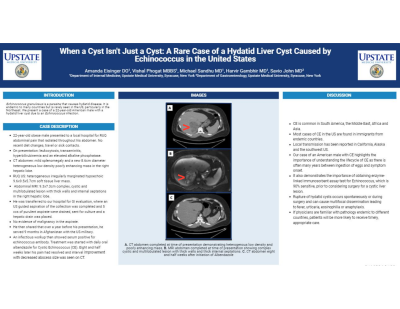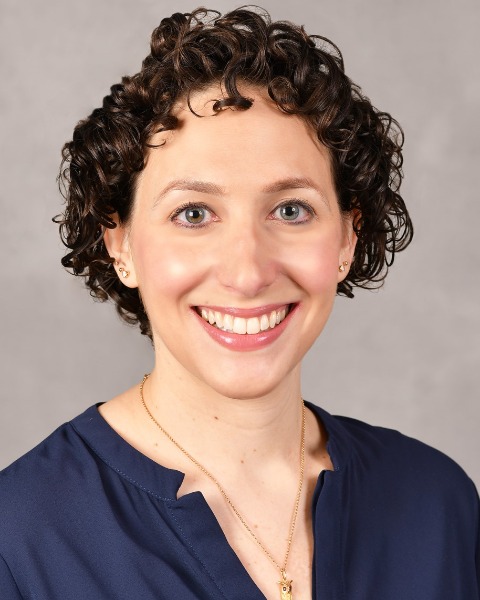Back


Poster Session D - Tuesday Morning
Category: Liver
D0550 - When a Cyst Isn't Just a Cyst: A Rare Case of a Hydatid Liver Cyst Caused by Echinococcus in the United States
Tuesday, October 25, 2022
10:00 AM – 12:00 PM ET
Location: Crown Ballroom

Has Audio

Amanda Eisinger, DO
SUNY Upstate Medical University
Syracuse, NY
Presenting Author(s)
Amanda Eisinger, DO1, Vishal Phogat, MBBS1, Michael Sandhu, MD1, Harvir Gambhir, MD1, Savio John, MD2
1SUNY Upstate Medical University, Syracuse, NY; 2State University of New York Upstate University Hospital, Syracuse, NY
Introduction: Echinococcus Granulosus is a parasite that causes hydatid disease. It is endemic to many countries but is rarely seen in the US, particularly in the Northeast. We present a case of a 22-year-old American male with a hydatid liver cyst due to an Echinococcus infection.
Case Description/Methods: 22-year-old obese male presented to a local hospital for RUQ abdominal pain that radiated throughout his abdomen. He denied recent diet changes, travel or sick contacts.On presentation the patient had leukocytosis, transaminitis, hyperbilirubinemia and an elevated alkaline phosphatase. CT abdomen showed mild splenomegaly and a new 8.6cm diameter heterogeneous low density poorly enhancing mass in the right hepatic lobe. RUQ US revealed a heterogeneous irregularly marginated hypoechoic 9.6x9.5x5.7cm soft tissue liver mass. Abdominal MRI showed a 9.3x7.3cm complex, cystic and multilobulated lesion with thick walls and internal septations in the right hepatic lobe. He was transferred to our hospital for GI evaluation, where an US guided aspiration of the collection was recommended. 5 ccs of purulent aspirate were drained, sent for culture and a hepatic drain was placed. There was no evidence of malignancy in the aspirate. He then shared that over a year before his presentation, he served 9 months in Afghanistan with the US military. An infectious workup then showed serum positive for echinococcus antibody. Treatment was started with daily oral albendazole for Cystic Echinococcus (CE). Eight and half weeks later his pain had resolved and interval improvement with decreased abscess size was seen on CT.
Discussion: CE is common in South America, the Middle East, Africa and Asia. Most cases of CE in the US are found in immigrants from endemic countries. Local transmission has been reported in California, Alaska and the southwest US. Our case of an American male with CE highlights the importance of understanding the lifecycle of CE as there is often many years between ingestion of eggs and symptom onset. It also demonstrates the importance of obtaining enzyme-linked immunosorbent assay test for Echinococcus, which is 90% sensitive, prior to considering surgery for a cystic liver lesion. Rupture of hydatid cysts occurs spontaneously or during surgery and can cause multifocal dissemination leading to fever, urticaria, eosinophilia or anaphylaxis. If physicians are familiar with pathology endemic to different countries, patients will be more likely to receive timely, appropriate care.

Disclosures:
Amanda Eisinger, DO1, Vishal Phogat, MBBS1, Michael Sandhu, MD1, Harvir Gambhir, MD1, Savio John, MD2. D0550 - When a Cyst Isn't Just a Cyst: A Rare Case of a Hydatid Liver Cyst Caused by Echinococcus in the United States, ACG 2022 Annual Scientific Meeting Abstracts. Charlotte, NC: American College of Gastroenterology.
1SUNY Upstate Medical University, Syracuse, NY; 2State University of New York Upstate University Hospital, Syracuse, NY
Introduction: Echinococcus Granulosus is a parasite that causes hydatid disease. It is endemic to many countries but is rarely seen in the US, particularly in the Northeast. We present a case of a 22-year-old American male with a hydatid liver cyst due to an Echinococcus infection.
Case Description/Methods: 22-year-old obese male presented to a local hospital for RUQ abdominal pain that radiated throughout his abdomen. He denied recent diet changes, travel or sick contacts.On presentation the patient had leukocytosis, transaminitis, hyperbilirubinemia and an elevated alkaline phosphatase. CT abdomen showed mild splenomegaly and a new 8.6cm diameter heterogeneous low density poorly enhancing mass in the right hepatic lobe. RUQ US revealed a heterogeneous irregularly marginated hypoechoic 9.6x9.5x5.7cm soft tissue liver mass. Abdominal MRI showed a 9.3x7.3cm complex, cystic and multilobulated lesion with thick walls and internal septations in the right hepatic lobe. He was transferred to our hospital for GI evaluation, where an US guided aspiration of the collection was recommended. 5 ccs of purulent aspirate were drained, sent for culture and a hepatic drain was placed. There was no evidence of malignancy in the aspirate. He then shared that over a year before his presentation, he served 9 months in Afghanistan with the US military. An infectious workup then showed serum positive for echinococcus antibody. Treatment was started with daily oral albendazole for Cystic Echinococcus (CE). Eight and half weeks later his pain had resolved and interval improvement with decreased abscess size was seen on CT.
Discussion: CE is common in South America, the Middle East, Africa and Asia. Most cases of CE in the US are found in immigrants from endemic countries. Local transmission has been reported in California, Alaska and the southwest US. Our case of an American male with CE highlights the importance of understanding the lifecycle of CE as there is often many years between ingestion of eggs and symptom onset. It also demonstrates the importance of obtaining enzyme-linked immunosorbent assay test for Echinococcus, which is 90% sensitive, prior to considering surgery for a cystic liver lesion. Rupture of hydatid cysts occurs spontaneously or during surgery and can cause multifocal dissemination leading to fever, urticaria, eosinophilia or anaphylaxis. If physicians are familiar with pathology endemic to different countries, patients will be more likely to receive timely, appropriate care.

Figure: A. CT abdomen completed at time of presentation demonstrating heterogenous low density and poorly enhancing mass. B. MRI abdomen completed at time of presentation showing complex cystic and multilobulated lesion with thick walls and thick internal septations. C. CT abdomen eight and half weeks after initiation of Albendazole
Disclosures:
Amanda Eisinger indicated no relevant financial relationships.
Vishal Phogat indicated no relevant financial relationships.
Michael Sandhu indicated no relevant financial relationships.
Harvir Gambhir indicated no relevant financial relationships.
Savio John indicated no relevant financial relationships.
Amanda Eisinger, DO1, Vishal Phogat, MBBS1, Michael Sandhu, MD1, Harvir Gambhir, MD1, Savio John, MD2. D0550 - When a Cyst Isn't Just a Cyst: A Rare Case of a Hydatid Liver Cyst Caused by Echinococcus in the United States, ACG 2022 Annual Scientific Meeting Abstracts. Charlotte, NC: American College of Gastroenterology.
